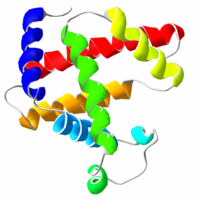Biomolecule
|
|

A biomolecule is a chemical compound that naturally occurs in living organisms. Biomolecules consist primarily of carbon and hydrogen, along with nitrogen, oxygen, phosphorus and sulfur. Other elements sometimes are incorporated but these are much less common.
Biomolecules are necessary for the existence of all known forms of life. For example, humans possess skin and hair. The main component of hair is keratin, an agglomeration of proteins which are themselves polymers built from amino acids. Amino acids are some of the most important building blocks used, in nature, to construct larger molecules. Another type of building block is the nucleotides, each of which consists of three components: either a purine or pyrimidine base, a pentose sugar and a phosphate group. These nucleotides, mainly, form the nucleic acids.
Besides the polymeric biomolecules, numerous small organic molecules are absorbed or synthesised by living systems. Many biomolecules may be useful or important drugs.
| Contents |
Types of biomolecules
A diverse range of biomolecules exist, including:
- Small molecules:
- Monomers:
- Polymers:
- Macromolecules:
Nucleosides and nucleotides
Nucleosides are molecules formed by attaching a nucleobase to a ribose ring. Examples of these include cytidine, uridine, adenosine, guanosine, thymidine and inosine.
Nucleosides can be phosphorylated by specific kinases in the cell, producing nucleotides, which are the molecular building blocks of DNA (deoxyribonucleic acid) and RNA (ribonucleic acid).
Saccharides
Monosaccharides are carbohydrates in the form of simple sugars.
Disaccharides are formed from two monosaccharides joined together. Monosaccharides and disaccharides are sweet, water soluble, and crystalline. Examples of monosaccharides include the hexoses (glucose, fructose, and galactose) and pentoses (ribose, deoxyribose). Examples of disaccharides include sucrose, maltose, and lactose.
Polysaccharides are polymerized monosaccharides, complex unsweet carbohydrates. They are, generally, large and often have a complex, branched, connectivity. They are insoluble in water and do not form crystals. Examples include starch, cellulose, and glycogen. Shorter polysaccharides, with 2-15 monomers, are sometimes known as oligosaccharides.
Lipids
Lipids are chiefly fatty acid esters, and are the basic building blocks of biological membranes. Another biological role is energy storage (e.g., triglycerides). Most lipids consist of a polar or hydrophilic head and one to three nonpolar or hydrophobic fatty acid tails, and therefore they are amphiphilic. Fatty acids consist of unbranched chains of carbon atoms that are connected by single bonds alone (saturated fatty acids) or by both single and double bonds (unsaturated fatty acids). The chains are usually 14-24 carbon groups long.
For lipids present in biological membranes, the hydrophilic head is from one of three classes:
- Glycolipids, whose heads contain an oligosaccharide with 1-15 saccharide residues.
- Phospholipids, whose heads contain a positively charged group that is linked to the tail by a negatively charged phosphate group.
- Sterols, whose heads contain a planar steroid ring, for example, cholesterol.
Hormones
Hormones are produced in the endocrine glands, where they are excreted into the bloodstream. They perform a wide range of roles in the various organs including the regulation of metabolic pathways and the regulation of membrane transport processes.
Hormones may be grouped into three structural classes:
- The steroids are one class of such hormones. They perform a variety of functions, but they are all made from cholesterol.
- Simple amines or amino acids.
- Peptides or proteins.
Amino acids
Amino acids are molecules that contain both amino and carboxylic acid functional groups. ( In biochemistry, the term amino acid is used when referring to those amino acids in which the amino and carboxylate functionalities are attached to the same carbon, plus proline which is not actually an amino acid).
Amino acids are the building blocks of long polymer chains. With 2-10 amino acids such chains are called peptides, with 10-100 they are often called polypeptides, and longer chains are known as proteins. These protein structures have many structural and functional roles in organisms.
There are twenty amino acids that are encoded by the standard genetic code, but there are more than 500 natural amino acids. When amino acids other than the set of twenty are observed in proteins, this is usually the result of modification after translation (protein synthesis). Only two amino acids other than the standard twenty are known to be incorporated into proteins during translation, in certain organisms:
- Selenocysteine is incorporated into some proteins at a UGA codon, which is normally a stop codon.
- Pyrrolysine is incorporated into some proteins at a UAG codon. For instance, in some methanogens in enzymes that are used to produce methane.
Besides those used in protein synthesis, other biologically important amino acids include carnitine (used in lipid transport within a cell), ornithine, GABA and taurine.
Protein structure
The particular series of amino acids that form a protein is known as that protein's primary structure. Proteins have several, well-classified, elements of local structure and these are termed secondary structure. The overall 3D structure of a protein is termed its tertiary structure. Proteins often aggregate into macromolecular structures, or quaternary structure.
Metalloproteins
A metalloprotein is a protein that contains a metal cofactor. The metal may be an isolated ion or may be coordinated with an nonprotein organic compound, such as the porphyrin group found in hemoproteins. In some cases, the metal is coordinated with both a side chain of the protein and an inorganic nonmetallic ion. This type of protein-metal-nonmetal structure is found in iron-sulfur clusters.
Vitamins
A vitamin is a compound that can not be synthesized by a given organism but is nonetheless vital to its survival or health. These compounds must be absorbed, or eaten, but typically only in trace quantities.
